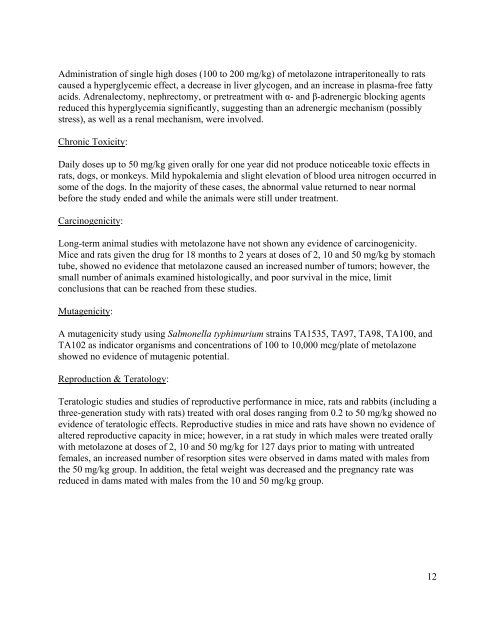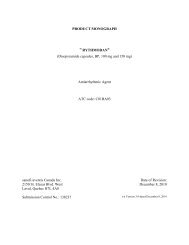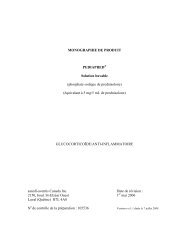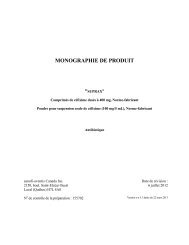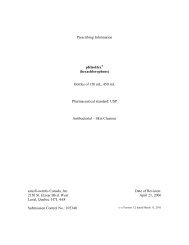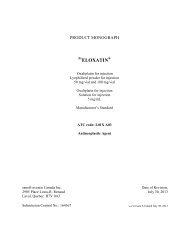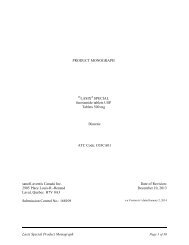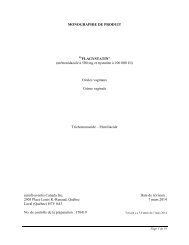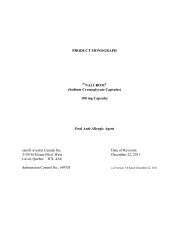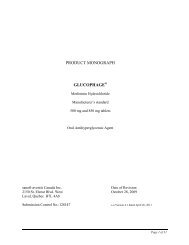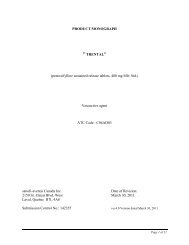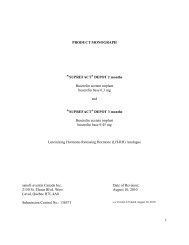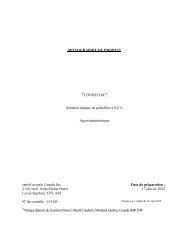Zaroxolyn (metolazone) - Sanofi Canada
Zaroxolyn (metolazone) - Sanofi Canada
Zaroxolyn (metolazone) - Sanofi Canada
You also want an ePaper? Increase the reach of your titles
YUMPU automatically turns print PDFs into web optimized ePapers that Google loves.
Administration of single high doses (100 to 200 mg/kg) of <strong>metolazone</strong> intraperitoneally to ratscaused a hyperglycemic effect, a decrease in liver glycogen, and an increase in plasma-free fattyacids. Adrenalectomy, nephrectomy, or pretreatment with α- and β-adrenergic blocking agentsreduced this hyperglycemia significantly, suggesting than an adrenergic mechanism (possiblystress), as well as a renal mechanism, were involved.Chronic Toxicity:Daily doses up to 50 mg/kg given orally for one year did not produce noticeable toxic effects inrats, dogs, or monkeys. Mild hypokalemia and slight elevation of blood urea nitrogen occurred insome of the dogs. In the majority of these cases, the abnormal value returned to near normalbefore the study ended and while the animals were still under treatment.Carcinogenicity:Long-term animal studies with <strong>metolazone</strong> have not shown any evidence of carcinogenicity.Mice and rats given the drug for 18 months to 2 years at doses of 2, 10 and 50 mg/kg by stomachtube, showed no evidence that <strong>metolazone</strong> caused an increased number of tumors; however, thesmall number of animals examined histologically, and poor survival in the mice, limitconclusions that can be reached from these studies.Mutagenicity:A mutagenicity study using Salmonella typhimurium strains TA1535, TA97, TA98, TA100, andTA102 as indicator organisms and concentrations of 100 to 10,000 mcg/plate of <strong>metolazone</strong>showed no evidence of mutagenic potential.Reproduction & Teratology:Teratologic studies and studies of reproductive performance in mice, rats and rabbits (including athree-generation study with rats) treated with oral doses ranging from 0.2 to 50 mg/kg showed noevidence of teratologic effects. Reproductive studies in mice and rats have shown no evidence ofaltered reproductive capacity in mice; however, in a rat study in which males were treated orallywith <strong>metolazone</strong> at doses of 2, 10 and 50 mg/kg for 127 days prior to mating with untreatedfemales, an increased number of resorption sites were observed in dams mated with males fromthe 50 mg/kg group. In addition, the fetal weight was decreased and the pregnancy rate wasreduced in dams mated with males from the 10 and 50 mg/kg group.12


